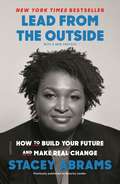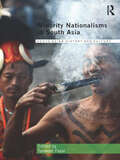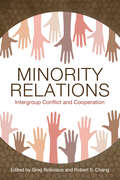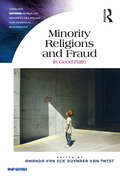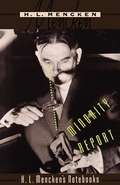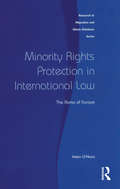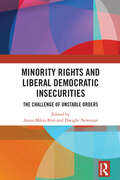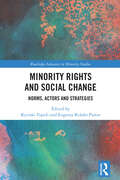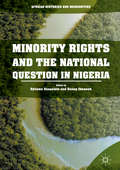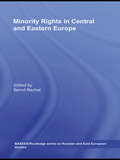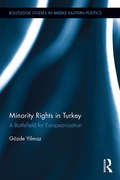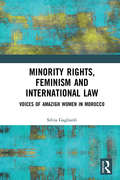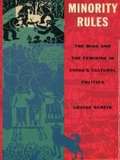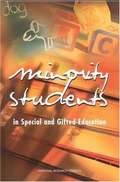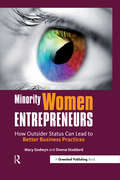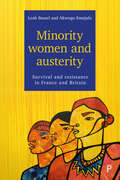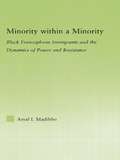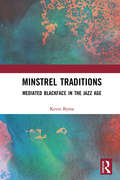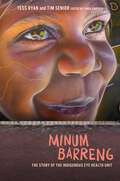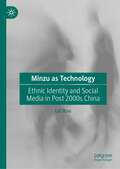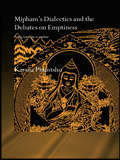- Table View
- List View
Minority Leader: How to Lead from the Outside and Make Real Change
by Stacey AbramsA personal and empowering blueprint―from one of America’s rising Democratic stars―for outsiders who seek to become the ones in charge <p><p> Leadership is hard. Convincing others―and often yourself―that you possess the answers and are capable of world-affecting change requires confidence, insight, and sheer bravado. Minority Leader is the handbook for outsiders, written with the awareness of the experiences and challenges that hinder anyone who exists beyond the structure of traditional white male power―women, people of color, members of the LGBTQ community, and millennials ready to make a difference. <p> In Minority Leader, Stacey Abrams argues that knowing your own passion is the key to success, regardless of the scale or target. From launching a company, to starting a day care center for homeless teen moms, to running a successful political campaign, finding what you want to fight for is as critical as knowing how to turn thought into action. Stacey uses her experience and hard-won insights to break down how ambition, fear, money, and failure function in leadership, while offering personal stories that illuminate practical strategies. <p> Stacey includes exercises to help you hone your skills and realize your aspirations. She discusses candidly what she has learned over the course of her impressive career: that differences in race, gender, and class are surmountable. With direction and dedication, being in the minority actually provides unique and vital strength, which we can employ to rise to the top and make real change. <p> <b>A New York Times Bestseller</b>
Minority Nationalisms in South Asia (Routledge South Asian History and Culture Series)
by Tanweer FazalSouth Asia is the theatre of myriad experimentations with nationalisms of various kinds - religious, linguistic, religio-linguistic, composite, plural and exclusivist. In all the region’s major states, officially promulgated nationalism at various times has been fiercely contested by minority groups intent on preserving what they see as the pristine purity of their own cultural inheritance.This volume examines the perspective of minority identities as they negotiate their terms of co-existence, accommodation and adaptation with several other competing identities within the framework of the ‘nation state’ in South Asia. It examines three different kinds of minority articulations – cultural conclaves with real or fictitious attachments to an imaginary homeland, the identity problems of dispersed minorities with no territorial claims and the aspirations of indigenous communities, tribes or ethnicities.The essays in this volume offer a rich menu: the evolution of Naga nationalism, the construction of the territory-less Sylheti identity, the debates over Pashtun nationalism in Pakistan, the evolution of Muslim nationalism in Sri Lanka, the politics of religious minorities in Bangladesh and Pakistan, the making of minority politics in India, and questions of Islam and nationalism in colonial India. It is an eclectic mix for students of nationalism, politics, modern history and anyone interested in the evolution of South Asia.This book was published as a special issue of South Asian History and Culture.
Minority Relations: Intergroup Conflict and Cooperation
by Greg Robinson and Robert S. ChangContributions by Taunya Lovell Banks, Devon W. Carbado, Robert S. Chang, Cheryl Greenberg, Tanya Katerí Hernández, Amanda O. Jenssen, Scott Kurashige, Greg Robinson, Stephen Steinberg, Clarence Walker, and Eric K. YamamotoThe question of how relations between marginalized groups are impacted by their common and sometimes competing search for equal rights has become acutely important. Demographic projections make it easy now to imagine a future majority population of color in the United States. Minority Relations: Intergroup Conflict and Cooperation sets forth some of the issues involved in the interplay among members of various racial, ethnic, and sexual minorities. Robert S. Chang initiated the Intergroup Conflict and Cooperation Project and invited historian Greg Robinson to collaborate. The two brought together scholars from different backgrounds and disciplines to engage a set of interrelated questions confronting groups generally considered minorities. This collection strives to stimulate further thinking and writing by social scientists, legal scholars, and policymakers on inter-minority connections. Particularly, scholars test the limits of intergroup cooperation and coalition building. For marginalized groups, coalition building seems to offer a pathway to addressing economic discrimination and reaching some measure of justice with regard to opportunities. The need for coalitions also acknowledges a democratic process in which racialized groups face significant difficulty gaining real political power, despite such legislation as the Voting Rights Act.
Minority Religions and Fraud: In Good Faith (Routledge Inform Series on Minority Religions and Spiritual Movements)
by Amanda Van Eck Duymaer Van TwistAnalysing both fraud and religion as social constructs with different functions and meanings attributed to them, this book raises issues that are central to debates about the limits of religious toleration in diverse societies, and the possible harm (as well as benefits) that religious organisations can visit upon society and individuals. There has already been a lively debate concerning the structural context in which abuse, especially sexual abuse, can be perpetrated within religion. Contributors to the volume proceed from the premise that similar arguments about ways in which structure and power may be conducive to abuse can be made about fraud and deception. Both can contribute to abuse, yet they are often less easily demonstrated and proven, hence less easily prosecuted. With a focus on minority religions, the book offers a comparative overview of the concept of religious fraud by bringing together analyses of different types of fraud or deception (financial, bio-medical, emotional, breach of trust and consent). Contributors examine whether fraud is necessarily intentional (or whether that is in the eye of the beholder); certain structures may be more conducive to fraud; followers willingly participate in it. The volume includes some chapters focused on non-Western beliefs (Juju, Occult Economies, Dharma Lineage), which have travelled to the West and can be found in North American and European metropolitan areas.
Minority Report: H. L. Mencken's Notebooks
by H. L. MenckenIn 1956, Mencken read through his notebooks and extracted those pieces he thought truest, most pertinent, most precise, or most likely to blow the dust out of a reader's brain, culminating in "Minority Report".
Minority Rights Protection in International Law: The Roma of Europe
by Helen O'NionsThere are approximately ten million Roma in Europe, making them the continent’s largest non-territorial minority. Despite this fact, the Roma continue to experience routine discrimination and marginalization in European countries. As a result they are seldom engaged in national political activism and are frequently at the bottom of the economic and social ladder. The severity of exclusion experienced by the Roma in societies which have long paid heed to the notion of individual, universal human rights - combined with their geographical dispersal and heterogeneous nature - makes the study of the Roma highly informative. This book examines the theoretical debate concerning the most appropriate way of protecting the fundamental human rights of the Roma, which also illuminates ways in which the rights of minority groups can be protected more generally. As a result, this work will be a valuable resource for social scientists and practitioners in the field of human rights.
Minority Rights and Liberal Democratic Insecurities: The Challenge of Unstable Orders
by Dwight Newman Anna-Mária Bíró Sean WallerThis book addresses the impact of a range of destabilising issues on minority rights in Europe and North America. This collection stems from the fact that liberal democracy did not bring about the ‘end of history’ but rather that the transatlantic region of Europe and North America has encountered a new era of instability, particularly since the global financial crisis. The transatlantic region may have appeared to be entering a period of stability, but terrorist attacks on the soil of Euro-Atlantic states, the financial crisis itself, and other changes including mass migration, the rise of populism, changes in fundamental political conceptions, technological change, and most recently the Covid pandemic, have brought increasing uncertainties and instabilities in existing orders. In these contexts, the book investigates the resulting difficulties and opportunities for minority rights. Bringing together scholars from a range of disciplines, and engaged in work on various unstable orders, the book provides a unique, and largely neglected, perspective on present developments as well as addressing the pressing issue of the future of the minority rights regime at global, regional, and national levels. This book will appeal to those with interests in minority rights, human rights, nationalism, law, and politics.
Minority Rights and Social Change: Norms, Actors and Strategies (Routledge Advances in Minority Studies)
by Kyriaki Topidi Eugenia Relaño PastorMinority movements tirelessly continue to engage in the process of social change, trying to promote and enforce minority protection norms and to have their world views, cultural practices, and norms recognized by the state. Through an examination of selected cases, this book problematizes how collective identities are not structurally guaranteed but rather constructed in dialectically interrelated positions and identity layers. The authors show the kind of impact that these processes can, or fail to, have on minority norms, actors, and strategies.Going beyond abstract normative principles, this collection reflects both Global North as well as Global South perspectives and examines through a variety of angles the role that race and ethnicity, culture, or religion play within social mobilization towards social change. The volume offers global insight on actor and strategy attempts to foster social change through the instrumental use and interpretation of minority rights as norms. This book will be of interest to those researching minority rights broadly understood within the disciplines of law, anthropology, sociology, and political science.
Minority Rights and the National Question in Nigeria
by Uyilawa Usuanlele Bonny IbhawohThis book offers a thematic study of key debates in the history of the ethnic politics, democratic governance, and minority rights in Nigeria. Nigeria provides a framework for examining the central paradox in post-colonial nation building projects in Africa - the tension between majority rule and minority rights. The liberal democratic model on which most African states were founded at independence from colonial rule, and to which they continue to aspire, is founded on majority rule. It is also founded on the protection of the rights of minority groups to political participation, social inclusion and economic resources. Maintaining this tenuous balance between majority rule and minority rights has, in the decades since independence, become the key national question in many African countries, perhaps none more so than Nigeria. This volume explores these issues, focusing on four key themes as they relate to minority rights in Nigeria: ethnic and religious identities, nationalism and federalism, political crises and armed conflicts.
Minority Rights in Central and Eastern Europe (BASEES/Routledge Series on Russian and East European Studies #Vol. 54)
by Bernd RechelMinority rights is an important issue in all modern states, but for those countries hoping to join the European Union the protection of minorities is a key condition for success in the accession process. This book provides a comprehensive assessment of minority rights in Central and Eastern Europe, covering all the countries of the region that have joined the EU since 2004, including Poland, Czech Republic, Hungary, Slovenia, Estonia, Lithuania, Latvia, Slovakia, Romania and Bulgaria. For each country it outlines the major developments since 1989, highlights the salient issues in minority rights politics, assesses the actual implementation of policies and legislation, explores the roles that domestic and international factors have played - including the impact of the EU succession process - and discusses whether there have been any major changes once EU accession was secured. Overall, this book is important for all those interested in European integration and minority rights politics, as well as for specialists on Central and Eastern Europe.
Minority Rights in Turkey: A Battlefield for Europeanization (Routledge Studies in Middle Eastern Politics)
by Gözde YilmazThe issue of minority rights is highly contested in both member and candidate states of the European Union. Compared with other policy areas, the Europeanization process in minority rights is much slower and more problematic. Turkey, though, differs from the majority of the member states by showing positive development, although admittedly it is still characterised by both accelerations and slowdowns. This book examines how minority protection, as a highly sensitive and controversial issue, is promoted or constrained in the EU’s neighbourhood, by focusing on the case of Turkey. It draws on current external Europeanization theories and suggests a rationalist model comprising both the role of the EU and also domestic factors. It integrates two models of external Europeanization provided by Schimmelfennig and Sedelmier (2005), i.e. the external incentives and lesson-drawing models, and the framework of the pull-and-push model of member state Europeanization by Börzel (2000), to derive a comprehensive model for external Europeanization. The book argues that the push by EU conditionality and the pull by domestic dissatisfaction are influential in promoting change. Without one or the other, domestic change remains incomplete, as it is either shallow or selective. Focusing on the Turkish case, the book enhances the theoretical understanding of external Europeanization by shifting focus away from EU conditionality to voluntarily driven change, and by providing a theoretical model that is applicable to other countries. It will therefore be a valuable resource for students and scholars studying minority rights and Turkish and European ethnic politics.
Minority Rights, Feminism and International Law: Voices of Amazigh Women in Morocco
by Silvia GagliardiInvestigating minority and indigenous women’s rights in Muslim-majority states, this book critically examines the human rights regime within international law.Based on extensive and diverse ethnographic research on Amazigh women in Morocco, the book unpacks and challenges generally accepted notions of rights and equality. Significantly, and controversially, the book challenges the supposedly ‘emancipatory’ power vested in the human rights project; arguing that rights-based discourses are sites of contestation for different groups that use them to assert their agency in society. More specifically, it shows how the very conditions that make minority and indigenous women instrumental to the preservation of their culture may condemn them to a position of subalternity. In response, and engaging the notion and meaning of Islamic feminism, the book proposes that feminism should be interpreted and contextualised locally in order to be effective and inclusive, and so in order for the human rights project to fully realise its potential to empower the marginalised and make space for their voices to be heard.Providing a detailed, empirically based, analysis of rights in action, this book will be of relevance to scholars, students and practitioners in human rights policy and practice, in international law, minorities’ and indigenous peoples’ rights, gender studies, and Middle Eastern and North African Studies.
Minority Rules: The Miao and the Feminine in China’s Cultural Politics
by Louisa ScheinMinority Rules is an ethnography of a Chinese people known as the Miao, a group long consigned to the remote highlands and considered backward by other Chinese. Now the nation's fifth largest minority, the Miao number nearly eight million people speaking various dialects and spread out over seven provinces. In a theoretically innovative work that combines methods from both anthropology and cultural studies, Louisa Schein examines the ways Miao ethnicity is constructed and reworked by the state, by non-state elites, and by the Miao themselves, all in the context of China's postsocialist reforms and its increasing exchange and fascination with the West. She offers eloquently argued interventions into debates over nationalism, ethnic subjectivity, and the ethnography of the state.Posing questions about gender, cultural politics, and identity, Schein examines how non-Miao people help to create Miao ethnicity by depicting them as both feminized keepers of Chinese tradition and as exotic others against which dominant groups can assert their own modernity. In representing and consuming aspects of their own culture, Miao distance themselves from the idea that they are less than modern. Thus, Schein explains, everyday practices, village rituals, journalistic encounters, and tourism events are not just moments of cultural production but also performances of modernity through which others are made primitive. Schein finds that these moments frequently highlight internal differences among the Miao and demonstrates how not only minorities but more generally peasants and women offer a valuable key to understanding China as it renegotiates its place in the global order.
Minority Students in Special and Gifted Education
by National Research CouncilSpecial education and gifted and talented programs were designed for children whose educational needs are not well met in regular classrooms. From their inceptions, these programs have had disproportionate representation of racial and ethnic minority students. What causes this disproportion? Is it a problem?Minority Students in Special and Gifted Education considers possible contributors to that disparity, including early biological and environmental influences and inequities in opportunities for preschool and K-12 education, as well as the possibilities of bias in the referral and assessment system that leads to placement in special programs. It examines the data on early childhood experience, on differences in educational opportunity, and on referral and placement. The book also considers whether disproportionate representation should be considered a problem. Do special education programs provide valuable educational services, or do they set students off on a path of lower educational expectations? Would students not now placed in gifted and talented programs benefit from raised expectations, more rigorous classes, and the gifted label, or would they suffer failure in classes for which they are unprepared?By examining this important problem in U.S. education and making recommendations for early intervention and general education, as well as for changes in referral and assessment processes, Minority Students in Special and Gifted Education will be an indispensable resource to educators throughout the nation, as well as to policy makers at all levels, from schools and school districts to the state and federal governments.
Minority Women Entrepreneurs: How Outsider Status Can Lead to Better Business Practices
by Mary Godwyn Donna StoddardHow does gender and minority status shape entrepreneurial decision-making? This question seems long overdue since minority women in the US start new businesses at four times the rate of non-minority men and women. This book is about minority women entrepreneurs in the United States. Though these women are thriving as business owners, their stories are very seldom told, and few think of minority women as successful entrepreneurs. Therefore, the first purpose of the book is to give voice and visibility to US minority women business owners. The second purpose is to explain what makes these women different from the standard white male business owners most people are familiar with. Through in-depth interviews and first-hand accounts from minority women entrepreneurs, the authors found that, in innovative and exciting ways, minority women use their outsider status to develop socially conscious business practices that support the communities with which they identify. They reject the idea that business values are separate from personal values and instead balance profits with social good and environmental sustainability. This pattern is repeated in statistical evidence from around the globe that women contribute a much higher percentage of their earnings to social good than do men, but until now there was no clear explanation of why. Using sociological and psychological theories, the authors explain why women, especially minority women, have a tendency to create socially responsible businesses. The innovations provided by the women in this study suggest fresh solutions to economic inequality and humanistic alternatives to exploitative business policies. This is a radically new, socially integrated model that can be used by businesses everywhere. This book is intended for undergraduate and graduate students of business, sociology, race and gender studies as well as practitioners of entrepreneurship, aspiring entrepreneurs, and all those looking for new examples of holistic, sustainable and socially responsible business practices.
Minority Women and Austerity: Survival and Resistance in France and Britain
by Leah Bassel Akwugo EmejuluIn the first book of its kind, Bassel and Emejulu explore minority women’s experiences of and resistances to austerity measures in France and Britain. Minority women are often portrayed as passive victims. However, Minority women and austerity demonstrates how they use their race, class, gender and legal status as a resource for collective action in the face of the neoliberal colonisation of non-governmental organisations, the failures of left-wing politics and the patronising initiatives of policy-makers. Using in-depth case studies, this book explores the changing relations between the state, the market and civil society which create opportunities and dilemmas for minority women activists. Through an intersectional ‘politics of survival’ these women seek to subvert the dominant narratives of ‘crisis’ and ‘activism’.
Minority Youth and Social Integration: The ISRD-3 Study in Europe and the US
by Mike Hough Sebastian RochéThis book examines the processes for social integration and social cohesion among young people, drawing on data collected from the International Self-Report Delinquency (ISRD) study, which covered 35 studies.This report examines case studies from 5 selected countries (France, Germany, the Netherlands, the United Kingdom, and the United States) to provide an in-depth comparative study.Social integration processes are defined by sociologists as the mechanisms through which a society is held together, and populations are transformed into collectivities and communities. They are understood by criminologists to be an important factor in crime prevention, and factors such as peer groups and families are strong determinants of criminal behavior. In a time when society, and particularly young people, can seem increasingly fragmented (due to new technologies, rapidly increasing migration, economic inequality, and increased individuation), the researchers in this volume seek to understand whether and how these phenomena affect young people, and how they may have an impact on the development of criminal and antisocial behavior.This work will provide a framework for researchers in criminology and criminal justice, particularly with an interest in juveniles, developmental criminology, and crime prevention, as well as related fields such as sociology, social work, and demography.
Minority within a Minority: Black Francophone Immigrants and the Dynamics of Power and Resistance (New Approaches in Sociology)
by Amal Ibrahim MadibboThis book examines the institutional racism and language discrimination that Black Francophones – who constitute a racial minority situated within a linguistic minority – face and identifies the strategies of resistance Black Francophones invent to gain access to power structures. The book is written to cover an area of research (Black Francophones) that is largely understudied. The book deals with the areas of immigration, race and anti-racism, gender, multiculturalism, linguistic minorities and francophone studies. It brings together multidisciplinary sociological and sociolinguistic theories and methodologies and sheds light on the discourse of institutional racism and resistance.
Minstrel Traditions: Mediated Blackface in the Jazz Age
by Kevin James ByrneMinstrel Traditions: Mediated Blackface in the Jazz Age explores the place and influence of black racial impersonation in US society during a crucial and transitional time period. Minstrelsy was absorbed into mass-culture media that was either invented or reached widespread national prominence during this era: advertising campaigns, audio recordings, radio broadcasts, and film. Minstrel Traditions examines the methods through which minstrelsy's elements connected with the public and how these conventions reified the racism of the time. This book explores blackface and minstrelsy through a series of overlapping case studies which illustrate the extent to which blackface thrived in the early twentieth century. It contextualizes and analyzes the last musical of black entertainer Bert Williams, the surprising live career of pancake icon Aunt Jemima, a flourishing amateur minstrel industry, blackface acts of African American vaudeville, and the black Broadway shows which brought new musical styles and dances to the American consciousness. All reflect, and sometimes incorporate, the mass-culture technologies of the time, either in their subject matter or method of distribution. Retrograde blackface seamlessly transitioned from live to mediated iterations of these cultural products, further pushing black stereotypes into the national consciousness. The book project oscillates between two different types of performances: the live and the mediated. By focusing on how minstrelsy in the Jazz Age moved from live performance into mediatized technologies, the book adds to the intellectual and historical conversation regarding this pernicious, racist entertainment form. Jazz Age blackface helped normalize new media technologies and that technology extended minstrelsy's influence within US culture. Minstrel Traditions tracks minstrelsy's social impact over the course of two decades to examine how ideas of national identity employ racial nostalgias and fantasias. This book will be of great interest to scholars and researchers in theatre studies, communication studies, race and media, and musical scholarship
Minum Barreng: The Story of the Indigenous Eye Health Unit
by Tess Ryan Tim SeniorThings happen during the life course to make vision loss increase, and many of these reasons can be traced to a lack of care, a lack of access to care, and the impact of colonisation. Minum Barreng: The Story of the Indigenous Eye Health Unit shines a light on the determined team who have worked with Aboriginal and Torres Strait Islander peoples since 2008 to prove that Australia has the will, the means and the moral obligation to close the gap in this serious health inequity. This is a story of vision in both senses of the word-and of strength and opportunity.
Minzu as Technology: Ethnic Identity and Social Media in Post 2000s China
by Lei HaoThis book provides a unique ethnographic approach to the understanding of ethnogenesis in the Chinese context, with a particular focus on how it is being reshaped in the post-2000s era. It reinterprets the Chinese concept of ethnicity, or minzu, by investigating its evolution in relation to the proliferation of media technologies. In an era characterized by digital connectivity, the quest for ethnic identity has taken on new dimensions. Ethnic groups, like the Sibe community from Xinjiang, are now extending beyond the state’s traditional interpretations of minzu. Leveraging the power of media technology, they are articulating and expressing their ethnic identities in new and personalised ways. These developments have led to the emergence of what this book terms ‘networked ethnicity,’ a fresh manifestation of ethnic identity formation in the era of social media. The pivotal question this book attempts to answer is: How does an ethnic group in China today understand its identity, and what role does technology and media play in that process? This exploration offers a critical perspective on the complex interplay between digital technology, individual agency, and ethnic identity formation. This study will be of interest to scholars of cultural studies, Chinese society, ethnic studies, and media studies, or anyone keen to understand the changing landscape of ethnic identity in the digital age.
Mipham's Dialectics and the Debates on Emptiness: To Be, Not to Be or Neither
by Karma PhuntshoThis is an introduction to the Buddhist philosophy of Emptiness which explores a number of themes in connection with the concept of Emptiness, a highly technical but very central notion in Indo-Tibetan Buddhism. It examines the critique by the leading Nyingma school philosopher Mipham (1846-1912) formulated in his diverse writings. The book focuses on related issues such as what is negated by the doctrine of emptiness, the nature of ultimate reality, and the difference between 'extrinsic' and 'intrinsic' emptiness. Karma Phuntsho's book aptly undertakes a thematic and selective discussion of these debates and Mipham's qualms about the Gelukpa understanding of Emptiness in a mixture of narrative and analytic style.
Miracle Cures: Saints, Pilgrimage, and the Healing Powers of Belief
by Robert A. ScottIconic images of medieval pilgrims, such as Chaucer’s making their laborious way to Canterbury, conjure a distant time when faith was the only refuge of the ill and infirm, and thousands traveled great distances to pray for healing. Why, then, in an age of advanced biotechnology and medicine, do millions still go on pilgrimages? Why do journeys to important religious shrines—such as Lourdes, Compostela, Fátima, and Medjugorje—constitute a major industry? In Miracle Cures, Robert A. Scott explores these provocative questions and finds that pilgrimage continues to offer answers for many. Its benefits can range from a demonstrable improvement in health to complete recovery. Using research in biomedical and behavioral science, Scott examines accounts of miracle cures at medieval, early modern, and contemporary shrines. He inquires into the power of relics, apparitions, and the transformative nature of sacred journeying and shines new light on the roles belief, hope, and emotion can play in healing.
Miracle at Sing Sing: How One Man Transformed the Lives of America's Most Dangerous Prisoners
by Ralph BlumenthalIn 1919, Lewis E. Lawes moved his wife and young daughters into the warden's mansion at Sing Sing prison. They shared a yard with 1,096 of the toughest inmates in the world-murderers, rapists, and thieves who Lawes alone believed capable of redemption. Adamantly opposed to the death penalty, Lawes presided over 300 executions. His progressive ideas shocked many, but he taught the nation that a prison was a community. He allowed a kidnapper to care for his children and a cutthroat to shave him every morning. He organized legendary football games for his "boys," and befriended Hollywood greats such as Charlie Chaplin and Humphrey Bogart. This is "A story almost too good to be true, but too true to miss." -Mario Cuomo
Miracle for Whom?: Chilean Workers Under Free Trade (New Political Economy Ser.)
by Janine BergMiracle for Whom? offers a fresh and insightful perspective to the debate on rising income inequality in Chile, and on the broader question of how free trade affects the demand for workers in developing countries.
